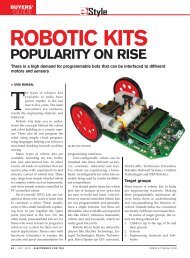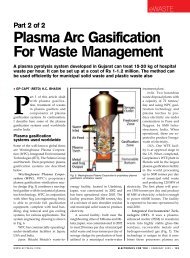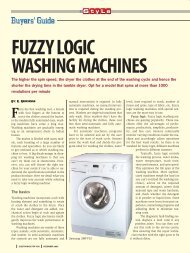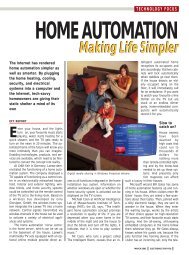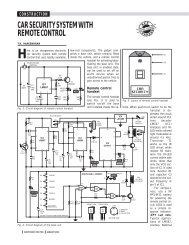inSide SeT-Top Box - Electronics For You
inSide SeT-Top Box - Electronics For You
inSide SeT-Top Box - Electronics For You
Create successful ePaper yourself
Turn your PDF publications into a flip-book with our unique Google optimized e-Paper software.
Looking inside<br />
<strong>inSide</strong> <strong>SeT</strong>-<strong>Top</strong> <strong>Box</strong><br />
STBs have enhanced our TV viewing experience through a host of value-added<br />
services. This article takes you deep inside a set-top box to provide you a<br />
complete overview of its architecture<br />
� amiT goel<br />
With the advent of digital<br />
television, set-top box (STB)<br />
has become a buzzword.<br />
While transmission of television signals<br />
has gone digital, most TVs are still<br />
analogue. Therefore an STB is required<br />
to convert the digital signal to analogue<br />
signal so as to enable a viewer to watch<br />
digital content on the TV set. However,<br />
an STB is not merely a digital to analogue<br />
signal converter, it also provides<br />
a host of other services to enhance the<br />
TV viewing experience—provision<br />
of electronic programme guide to<br />
keep track of the content is one such<br />
example.<br />
This article aims to take you deep<br />
into the set-top box to enhance your<br />
understanding about the STB hardware<br />
architecture.<br />
STB hardware components<br />
The STB mainly consists of following<br />
components:<br />
Antenna. The antenna is not essentially<br />
the part of a set-top box, as<br />
it is fitted outside an STB. It contains<br />
low-noise block (LNB) that receive<br />
the satellite signal with a frequency of<br />
approximately 12 GHz and performs a<br />
down conversion to a frequency range<br />
of 950 to 1450 MHz. Subsequently, the<br />
signal is passed on to the ‘front end’<br />
inside the set-top box.<br />
Power supply. Power supply provides<br />
the required voltage to run various<br />
peripherals inside an STB. In some cases,<br />
it can be used to power mechanised antennae<br />
to align them in various directions<br />
in order to receive different signals.<br />
Front panel. It is a small microcontroller-based<br />
hardware peripheral<br />
inside an STB that receives the user<br />
Fig. 1: Various hardware components inside an STB<br />
input and interacts directly with the<br />
main CPU control (processor). It contains<br />
an IR receiver to listen to remote<br />
control input. Also, it is directly linked<br />
to some input buttons or keys present<br />
on the outer frame of an STB.<br />
Front end. It is also known as Network<br />
Interface Module (NIM). Front end<br />
is a peripheral device that interacts with<br />
the antenna to receive the down converted<br />
signal and send it to digital decoder<br />
in the form of a transport stream. Basically,<br />
the front end consists of two major<br />
components—tuner and demodulator.<br />
The tuner listens to the signal received<br />
from the antenna and passes it on to the<br />
demodulator for generating the transport<br />
stream. Different types of NIMs are<br />
satellite QPSK, cable QAM, terrestrial<br />
COFDM, 8-VSB and telco ADSL.<br />
Digital decoder. A digital decoder<br />
receives the transport stream sent by the<br />
demodulator inside the front end and<br />
then demultiplexes and decompresses<br />
the requested video by the user. It then<br />
converts the digital stream to an analogue<br />
signal, which is sent to RF port.<br />
The task of the demultiplxer or a demux<br />
is to separate all the data streams<br />
packaged together by the HeadEnd in<br />
the specified format. The data contains<br />
audio, video and DVB (digital video<br />
broadcasting) specified data like SI/PSI<br />
tables. After the demuxing, decompression<br />
is done by a specified decoder<br />
in specified formats like MPEG-2 or<br />
MPEG-4. The specific data or information<br />
is given to CPU for processing for<br />
advanced features and memory storage<br />
and to be used in graphics.<br />
CPU (Processor). Just as in a regular<br />
PC, the processor inside the CPU takes<br />
care of interactions of all the hardware<br />
peripherals and software modules inside<br />
a set-top box. It manages the Real-<br />
Time Operating System (RTOS). The<br />
processor also takes care of memory<br />
devices and other forms of digital stor-<br />
1 2 2 • Janua ry 2 0 1 0 • e lectronics for you w w w . e f y m a g . c o m
Fig. 2: An example of a set-top box hardware<br />
age like hard disks or flash drives.<br />
Digital storage. Digital storage is<br />
another optional component inside a<br />
set-top box. It is needed for persistent<br />
storage of any kind of data including<br />
audio/video. It communicates with<br />
the processor and is controlled by STB<br />
software modules and storage drivers.<br />
In fact, it is a hard disk which acts as a<br />
digital storage media inside an STB.<br />
CA module. The conditional access<br />
(CA) module can be considered as the<br />
most important component of a settop<br />
box. This module is virtually the<br />
lifeline of all the leading set-top box<br />
solution providers. This peripheral,<br />
called Integrated Conditional Access<br />
Module (ICAM), is placed before the<br />
demultiplexer to be used for descrambling<br />
the encrypted signal, and also<br />
provide a smartcard interface for various<br />
security features.<br />
Return path. This is an optional<br />
component. A return path is used by<br />
an STB to communicate back with the<br />
HeadEnd and send data packets. The<br />
return path can be present in various<br />
forms like a PSTN line connection,<br />
a cable modem in case of cable STBs<br />
or an ethernet jack in IP set-top box<br />
using ADSL broadband modems. <strong>For</strong><br />
example, a return path becomes a<br />
necessary component if a user needs<br />
w w w . e f y m a g . c o m<br />
to purchase PPV (pay per view) events<br />
directly from the set-top box using<br />
credit cards.<br />
Other peripherals. There are other<br />
optional peripherals present inside an<br />
STB like RS-232 port, USB port, Wi-<br />
Fi enablers, Bluetooth devices. These<br />
peripherals are used inside an STB<br />
for enhanced interactivity with the<br />
consumer and provide better user experience.<br />
Basically, these components<br />
or peripherals can be used for creating<br />
advanced features like file sharing and<br />
plugging in external devices.<br />
Flow of data<br />
As you must have understood the roles<br />
of various hardware modules inside<br />
an STB, let’s move on to the next level,<br />
where we’ll go through the flow of<br />
data between these hardware while we<br />
tune an STB to a particular channel.<br />
The tuner receives modulated digital<br />
transmission from the antenna and<br />
passes it on to the demodulator. This demodulator<br />
takes into account the type of<br />
demodulation (like QPSK ) and forward<br />
error correction to give out a transport<br />
stream, which is a digital stream of bytes<br />
known as data packets. According to<br />
DVB standards, a transport stream is of<br />
the size of 188 bytes. It then goes into the<br />
demux where the content is separated<br />
Looking inside<br />
electronics for you • J a n ua ry 2 0 1 0 • 123
Looking inside<br />
in audio/video packetised elementary<br />
stream (PES) and data packets known<br />
as sections, as per DVB standards. PES<br />
is a mechanism to carry audio/video<br />
elementary streams in packet format<br />
inside an MPEG-2 transport stream.<br />
Sections are the data packets containing<br />
information regarding the audio/video<br />
content and other metadata. Once the<br />
demux does its job, audio/video is sent<br />
to MPEG-2/MPEG-4 decoder which<br />
gives the output to the RF port to display<br />
the video on television.<br />
The data packets are sent to the<br />
processor used by the STB software to<br />
enable viewing. This data can be persistent<br />
or kept in RAM as per the needs and<br />
performance. Any kind of user request,<br />
be it tuning or a purchase, goes through<br />
the CPU. In between, the most important<br />
functionality of descrambling is<br />
performed by a descrambler embedded<br />
inside the ICAM part of the chipset. In<br />
some variants of STBs, a descrambler can<br />
be a part of a decoder, or it can exist independently.<br />
The descrambler takes care<br />
of decrypting the encrypted transport<br />
stream using the control word technique.<br />
Generally, these descramblers and control<br />
word algorithms are closely-guarded<br />
secrets with CA solution providers to<br />
prevent hackers from decrypting the signal.<br />
These are developed in conjunction<br />
with chipset vendors in a very secured<br />
environment.<br />
memory<br />
Moving on further, let’s discuss some<br />
of the memory types used inside an<br />
STB. It contains various memory types<br />
for different roles.<br />
• DRAM (dynamic random access<br />
memory) is used to store all the software<br />
needs and volatile working area<br />
like static variables.<br />
• Video DRAM is used in an STB<br />
for storing the decoded video image<br />
that is being output to television or<br />
video recorder.<br />
• NVRAM (non volatile random access<br />
memory) is needed for persistent<br />
memory needs of the STB. Generally,<br />
STB configurations are written into<br />
NVRAM to keep the settings persistent<br />
Fig. 3: Flow control between various STB hardware components<br />
during power cycles and provide consistent<br />
user experience. There are two<br />
types of NVRAMs used inside a set-top<br />
box, namely, Electrically Erasable Progammable<br />
Read Only Memory (EEP-<br />
ROM) and FLASH. EEPROM is phasing<br />
out slowly as it is very expensive<br />
to perform frequent read and writes,<br />
whereas FLASH uses batch mode for<br />
read and write and enhances the life<br />
of NVRAM. Also, FLASH can be used<br />
for storing parts of code segment for<br />
software performance reasons.<br />
• ROM/OTP (read only memory/<br />
one time programmable): As the name<br />
suggests, this is the memory written on<br />
to once in a lifetime of set-top box. It<br />
contains some crucial software pieces<br />
like boot loader and other securityrelated<br />
code. The boot loader enables<br />
the STB to check the integrity of the<br />
software and let it work only if it contains<br />
authentic software. This is one of<br />
the key memory areas which protect<br />
the STB from hackers to write illegal<br />
software into the box.<br />
As mentioned earlier, the most important<br />
part in an STB design is ICAM<br />
or CA module, which is responsible<br />
for the viewer’s access to the content<br />
available on air. It maintains all the<br />
transactions and performs validations<br />
to check the entitlement of the viewer<br />
to selected programme. ICAM module<br />
consists of Entitlement Control Message<br />
(ECM) and Entitlement Manage-<br />
ment Message (EMM) acquisition and<br />
management, descrambler and smart<br />
card interface. ECMs and EMMs are<br />
the ways of communication used by<br />
broadcaster to an STB. Smart card<br />
interface provides access to secured<br />
information like passwords, parental<br />
lock information, purchase information<br />
and all other kinds of transactional<br />
details. The most important part is the<br />
descrambler that uses the secure control<br />
word to descramble the video. It is the<br />
key to enable the video to be decoded.<br />
The input transport stream is sent to<br />
descrambler as an input having a specific<br />
parity. Depending on this parity,<br />
respective control word is generated<br />
and used to descramble the video. The<br />
descrambling is done in hardware due<br />
to performance and security reasons.<br />
Doing it in hardware does not expose<br />
the control word beyond silicon and it<br />
does it much faster without stopping<br />
the input stream.<br />
In a nutshell, set-top box hardware<br />
architecture is very similar to architectures<br />
of any recorder and replay<br />
device. But its uniqueness lies in its<br />
security model and the enhanced interactivity<br />
with viewers, enabling them<br />
to perform various actions during live<br />
video and also pay only for the content<br />
they watch. �<br />
The author is working with a leading digital television<br />
solutions provider<br />
1 2 4 • Janua ry 2 0 1 0 • e lectronics for you w w w . e f y m a g . c o m



